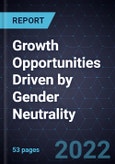Gender-sensitive Business Models for Transformational Growth
In the last few years, the practice of identifying someone based on their gender has lost importance. People have realized the extent of gender-based discrimination in society, in the workplace, and in the marketplace. More and more people have chosen to declare themselves nonbinary, to avoid being confined by the traditional definition of male or female. Gen Z and millennials have driven this gender-neutral movement and boosted the preference for gender-neutral products and services, primarily Gen Z. By 2030, Gen Zs will make up the largest percentage of both the working-age population and the consumers; therefore, gender-neutral policies and strategies will be a priority for businesses and governments. Gender-neutral products and services, gender-neutral pronouns, nonbinary workplace strategies, gender-neutral textbooks, and activities are some of the major strategies that will be implemented within the retail, education, and business administration space.
This study highlights gender-neutrality trends across societies and businesses. It offers a comprehensive analysis of the strategies, ideas, products, and business models focusing on gender neutrality. The study starts with an analysis of the shifting trend among the generations toward the adoption of gender neutrality. It also includes how countries have been accepting nonbinary norms over the years. Next, it highlights sectors where this movement has been adopted already. The study also offers a detailed analysis of the strategies/ policies driving the gender-neutrality movement across the sectors. It also identifies the role of companies or businesses, organizations, and governments in driving the gender-neutrality movement. The study also highlights three growth opportunities, which will have a huge impact in the years to come.
Key Issues Addressed
- What are the major drivers of the gender neutrality movement?
- How has the gender neutrality movement been accepted across generations and regions?
- What are the major sectors where this movement has impacted heavily?
- What are the major policies or strategies designed to cater to this nongendered movement? What is the role of governments here?
- What is the regional reach of this movement today and in the future?
- What are the critical success factors that companies seeking to cater to this trend should consider?








